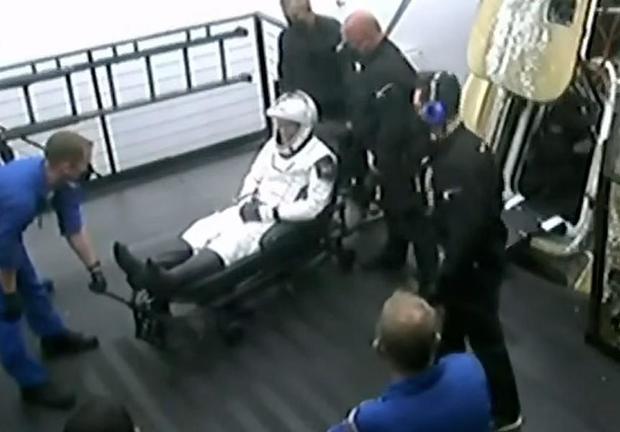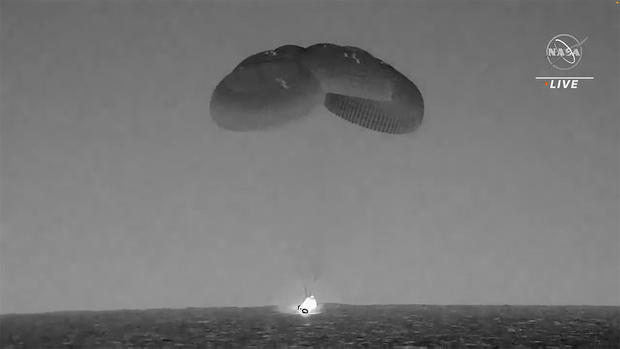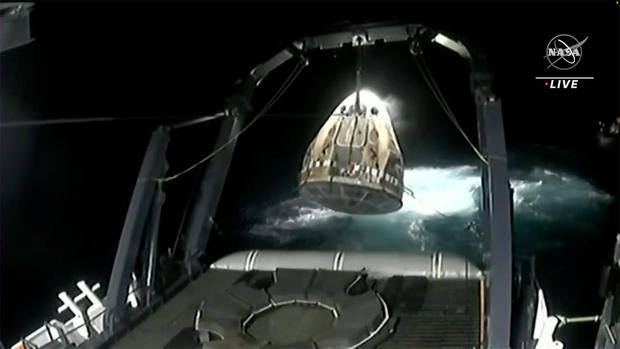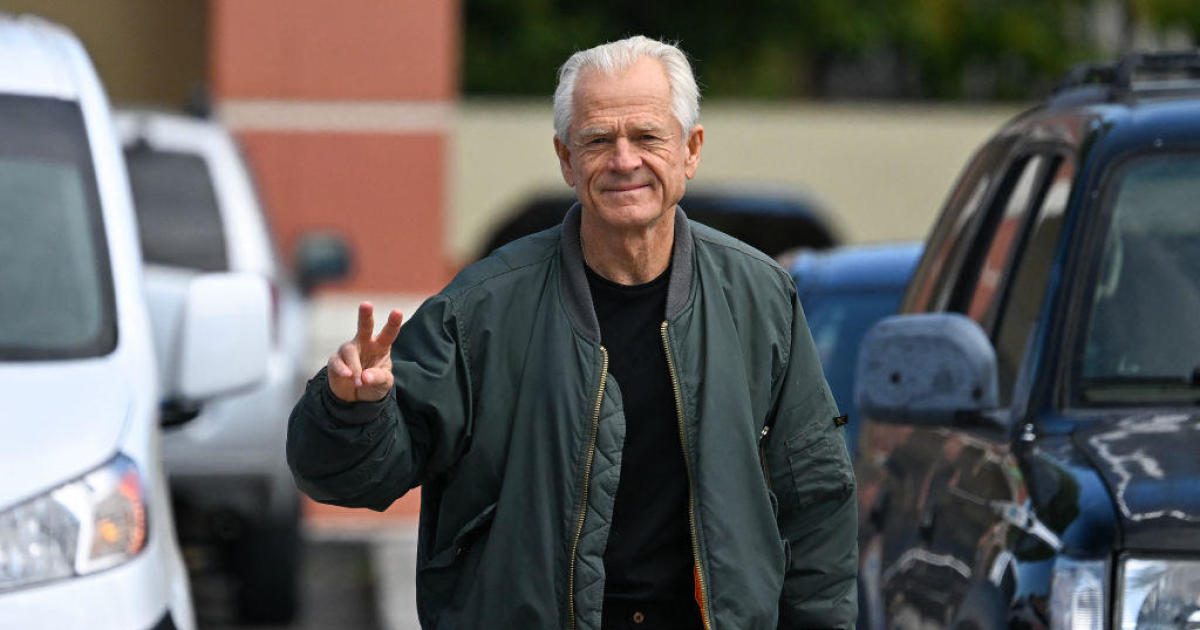SpaceX Crew Dragon brings 4 space station fliers back to Earth after 6-month voyage
Blazing like a meteor as it streaked high above northern Florida, a SpaceX Crew Dragon spacecraft safely carried four space station fliers back to Earth early Monday, splashing down in the Atlantic Ocean east of Jacksonville to wrap up a six-month stay in orbit.
Crew-6 commander Stephen Bowen, pilot Woody Hoburg, cosmonaut Andrey Fedyaev and UAE crewmate Sultan Alneyadi undocked from the station's forward Harmony module at 7:05 a.m. EDT Sunday to kick off a 17-hour flight back to Earth.
The automated Crew Dragon executed a 16-minute de-orbit thruster firing starting at 11:24 p.m., slowing the spacecraft by about 250 mph -- just enough to drop it back into the lower atmosphere for a steep southwest-to-northeast trajectory carrying it above Central America and north Florida.
Viewed from the Kennedy Space Center, the returning spacecraft looked like a slow-motion meteor blazing a brilliant trail across the sky as the Crew Dragon was enveloped in a cloud of super-heated plasma, slowing from orbital velocity of 17,100 mph to just 300 mph or so in a matter of minutes.
With SpaceX recovery crews and NASA observers standing by, the capsule's four main parachutes deployed on time, filled with air and lowered the spacecraft to a gentle splashdown in the Atlantic off Florida's east coast at 12:17 a.m.
"On behalf of NASA and SpaceX, welcome back home," a flight controller radioed from the California rocket builder's control room. "Thank you for flying SpaceX."
"We greatly appreciate all the support, from all the initial training, to the launch, throughout the mission. ... This has been incredible," Bowen replied. "We certainly appreciate it and look forward to working with you all again."
The deep overnight landing was the result of a combination of factors tied to the space station's orbit and the Crew Dragon's ability to reach a specified target on a specific date within required weather constraints and other factors. In this case, that all worked out to a late night descent.
SpaceX crews reached the Crew Dragon within minutes of splashdown. After making sure no propellant vapors were present, cables were connected and the spacecraft was hauled aboard the SpaceX recovery ship. As usual with long-duration flights, recovery personnel planned to carry Bowen and company out of the Crew Dragon, one at a time, as they began readjusting to the unfamiliar tug of gravity.
Before departing the space station, Bowen, a former submariner, said he most looked forward to "the nice ocean air and peaceful calm seas. That'll be really nice to get back to."
Hoburg said he was looking forward to "a real shower." Alneyadi said he couldn't wait to rejoin friends and family, along with enjoying "a real hot cup of coffee." As for Fedyaev, "I think my dream is a bed for good sleeping. I can lay on one side. Another side. My back. Sleeping!"
After initial medical checks aboard the recovery ship, all four fliers will be flown to shore by helicopter. A NASA jet was standing by to carry them back to Houston and the Johnson Space Center for debriefing and reunions with friends and family.
Left behind in orbit were three Soyuz crew members -- station commander Sergey Prokopyev, Dmitri Petelin and NASA astronaut Frank Rubio -- and four Crew Dragon fliers launched August 26 to replace Bowen and company: Crew-7 commander Jasmin Moghbeli, European Space Agency astronaut Andreas Mogensen, Japanese astronaut Satoshi Furukawa and cosmonaut Konstantin Borisov.
Prokopyev, Petelin and Rubio were launched to the station last September and are wrapping up a marathon 371-day mission.
They originally planned to spend six months in space, but their Soyuz ferry ship was disabled by a major coolant leak last December. The Russians opted to send up a replacement spacecraft, and the crew's mission was extended by six months.
A fresh Soyuz crew -- commander Oleg Kononenko, Nikolai Chub and NASA astronaut Loral O'Hara -- is scheduled for launch from the Baikonur Cosmodrome in Kazakhstan on September 15.
Prokopyev, Petelin and Rubio will undock and return to Earth 12 days later. In so doing, Rubio will set a new U.S. record for the longest single spaceflight by an American astronaut.
Launched atop a SpaceX Falcon 9 rocket on March 2, the Crew-6 fliers spent 185 days and 22 hours off planet, circling the globe 2,976 times while traveling 78.9 million miles through space. At splashdown, Bowen, the only space veteran on the crew, had logged 227 days in space across four missions.
Over the course of their mission, the Crew-6 astronauts welcomed seven visiting vehicles, including two unpiloted Cargo Dragon spacecraft, two Russian Progress supply ships, a Northrop Grumman Cygnus cargo carrier and two piloted Crew Dragons.
They also carried out three spacewalks. Bowen an Hoburg ventured outside twice to install new roll-out solar blankets and Alneyadi joined Bowen for a third excursion to retrieve a failed antenna package and to carry out other maintenance.
"It's certainly been the experience of a lifetime, and a real honor to get to spend six months, six incredibly short-feeling months, living and working aboard this incredible orbiting outpost," Hoburg said before departing the station. "I think we got a lot done."








